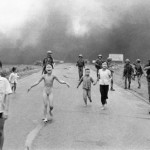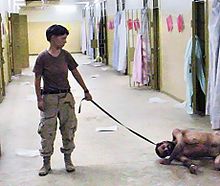What Is America’s Code of Morality?
by Kim Petersen
uruknet.info
 |
What we saw in Syria last week should shock the conscience of the world. It defies any code of morality. – US Secretary of state, John KerryJohn Kerry is correct. The massacre in Syria was a moral obscenity. However, just how credible is Kerry’s railing against the perpetrators of the massacre in the suburbs of east Damascus? Kerry spoke of the "gut wrenching" emotions he felt: "As a father, I can’t get the image out of my head of a man who held up his dead child, wailing while chaos swirled around him; the images of entire families dead in their beds without a drop of blood or even a visible wound; bodies contorting in spasms; human suffering that we can never ignore or forget." Does Kerry’s memory falter when one applies a code of morality to US crimes past and present?  1) Hiroshima and Nagasaki.
With World War II winding down in 1945, the US military dropped two
non-discriminating (because they destroy everything and everyone in its
blast radius) nuclear bombs on civilian-populated cities killing about
200,000 humans. 1) Hiroshima and Nagasaki.
With World War II winding down in 1945, the US military dropped two
non-discriminating (because they destroy everything and everyone in its
blast radius) nuclear bombs on civilian-populated cities killing about
200,000 humans. 2) Tokyo holocaust. "More people were killed in the Tokyo firebombing of March 9-10 than in the atomic bombings of Hiroshima and Nagasaki five months later… During the March 9-10 raid, some 1,700 tons of incendiary bombs were scattered across Tokyo’s densely populated Shitamachi (downtown) district in an effort to disrupt war production and destroy Japanese morale. The firestorm boiled water in Tokyo’s rivers and canals, melted glass and towering columns of heat brought down nearly a dozen B-29s."1 3) Burning civilians. On 13 February 1991 the US air force targeted a civilian air-raid shelter in Amiriyah, Iraq, incinerating the 408 civilians inside. 4) Half a million kids worth killing. On 12 May 1996, on the current affairs show 60 Minutes, TV journalist Lesley Stahl posed a question to then US ambassador to the UN, Madeleine Albright, on US sanctions against Iraq: "We have heard that a half million children have died. I mean, that’s more children than died in Hiroshima. And, you know, is the price worth it?" Albright responded: "I think this is a very hard choice, but the price–we think the price is worth it." [emphasis added]  5) Napalm. US forces widely used napalm, a fuel gel that sticks and burns through flesh, in Viet Nam. The humans who were scorched by napalm became casualties of war. The US also used napalm more recently in Iraq along with white phosphorus, another burning chemical.2 6) "… the supreme international crime, differing only from other war crimes in that it contains within itself the accumulated evil of the whole." That is how the International Military Tribunal at Nuremberg described the crime of aggression. UN secretary general Kofi Annan held that the US attack on Iraq was illegal.3 Benjamin Ferencz, a former chief prosecutor of the Nuremberg Trials, stated of the invasion of Iraq by the US and its allies that a "prima facie case can be made that the United States is guilty of the supreme crime against humanity, that being an illegal war of aggression against a sovereign nation."4 7) US convicted in World Court of terrorism. In the 1984 case The Republic of Nicaragua v. The United States of America, the International Court of Justice ruled the US had wielded "unlawful use of force" for mining the Nicaraguan ports, violating Nicaraguan air space, and aiding insurgents to bring about a coup. The US was ordered to pay reparations, but it ignored the judgement.  8. Torture. The US is a signatory to the Convention against Torture and Other Cruel, Inhuman or Degrading Treatment or Punishment. Yet its CIA engages in renditions, kidnapping, and torture. A nefarious case is that of Khalid el-Masri, who during the GW Bush presidency, was kidnapped and tortured by the CIA — including "forced anal penetration."5 The military is sullied by torture at gulags such as Bagram, Abu Ghraib, and Gunatanamo Bay. Stripping, waterboarding, attack dogs, sleep deprivation, and stress positions are standard tactics used against prisoners-of-war. 9. Killing as a video game. It used to be that refusing to face your enemy in combat was considered the nadir of cowardice. US forces (despite overwhelming superiority in weaponry) are increasingly less likely to face their designated enemies. The killing is more and more being carried out by joystick wielding drone operators thousands of kilometers from the battlefield. The presumption of innocence does not apply to targets, as they are summarily executed by executive fiat. President Barack Obama is judge, jury, and arms-length executioner. Civilians become collateral fatalities in drone warfare.6 10. Wounded Knee. While Lakota chief Spotted Elk was leading his people to consult Red Cloud and other Oglala leaders about brokering peace with the government, they were intercepted by the Seventh Calvary near Wounded Knee Creek. Two hundred and seventy to 300 Lakota were massacred; 170 to 200 were women and children.7 The infamy of US government depredations against the Lakota would occur again at Wounded Knee. Between 1973 and 1976, 69 American Indian Movement activists were murdered at Oglala Oyanke (Pine Ridge Nation).8 What Morale Code Does the US Regime Follow? When discussing moral obscenities what should one conclude about a nation state founded in racism and genocide of the Original Peoples? The so-called father of the US, George Washington, saw Indians as wolves: "both being beasts of prey, tho’ they differ in shape."9 The Haudenosaunee called Washington the "town destroyer" for wiping out their villages.10 Thomas Jefferson boasted: "in war, they will kill some of us; we shall destroy all of them."11 Andrew Jackson referred to the Original Peoples as "savage dogs" and bragged of preserving a scalp collection.12 Theodore Roosevelt’s racism was unabashed, "I don’t go so far as to think that the only good Indians are dead Indians, but I believe nine out of ten are, and I shouldn’t inquire too closely into the case of the tenth."13 The list of acts by the US of A, whose morality is highly dubious, would be exhaustive: slavery, lynchings, imperialism, colonialism, regime changes, supporting Zionism and its crimes against the Palestinian people, internment camps, hyperbolic incarceration rates, capital punishment, poverty, spy wars, class war, drug wars, cyber wars, military invasions, war on whistleblowers, war upon war, etc. Echoing the words of John Kerry: what does all this reveal about America’s code of morality? How does it affect (or does it affect?) the conscience of Kerry? The conscience of the citizenry of the USA? The conscience of the world? Assuming that the aforementioned plethora of evidence is factually accurate, does Kerry’s posturing and fulmination not represent a moral obscenity? The iniquity of Kerry’s false moral consciousness is its deceitful intent: to serve as a pretext for carrying out a moral obscenity against Syria. War correspondent Chris Hedges was forthright about the US moral code: We accept, if not condone, the maiming and killing of others as the regrettable cost of war. We operate under a new moral code.14
Source |
No comments:
Post a Comment